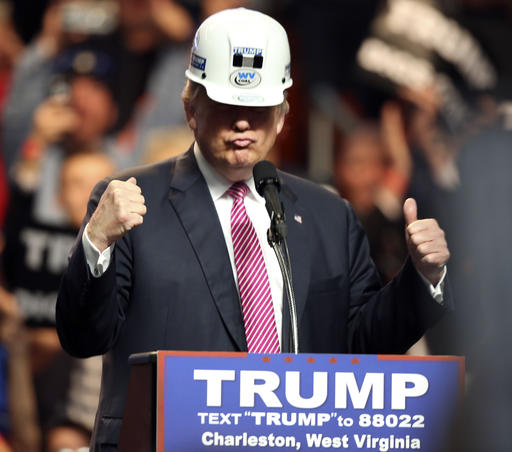Trump keeps pandering to the coal miners
August 10, 2016 by Ken Ward Jr.
Certainly, Republican presidential candidate Donald Trump’s statements about the coal industry aren’t the comments that are getting the most attention the last couple of days. Still, for coalfield residents thinking ahead to this fall’s campaign — and not only to the presidential race, but others as well — looking at what Trump is trying to sell is worthwhile.
Chris Mooney at The Washington Post revisits it in a piece headlined, “Dear Donald Trump: This is what is really dismantling the coal industry.”
As Mooney notes, Trump talked about coal during his big economic speech Monday in Detroit:
Also critical to our economic renewal will be energy reform.
The Obama-Clinton Administration has blocked and destroyed millions of jobs through their anti-energy regulations, while raising the price of electricity for both families and businesses.
As a result of recent Obama EPA actions coal-fired power plants across Michigan have either shut down entirely or undergone expensive conversions. The Obama-Clinton war on coal has cost Michigan over 50,000 jobs. Hillary Clinton says her plan will “put a lot of coal companies and coal miners out of business.”
We will put our coal miners and steel workers back to work.
Clinton not only embraces President Obama’s job-killing energy restrictions but wants to expand them, including going after oil and natural gas production that employs some 10 million Americans.
But, citing the latest U.S. Energy Information Administration data, Mooney explains:
Sure, some Obama era regulations have been bad news for the industry. More broadly, coal is in a uniquely poor position, among energy sources, in the new environmental era that the world is now entering. Any utility company making decisions about its future energy mix will be thinking about this.
But equally bad news for coal has come in the form of very cheap natural gas, which has arrived in this country precisely because the fracking-driven shale gas industry — with which Trump is also seemingly aligned — has thrived during Obama’s presidency.
In fact, if you dig into the EIA report, you’ll read this:
U.S. coal production in July was 65 million short tons (MMst), an 8 MMst (14%) increase from the previous month but 11 MMst (15%) lower than in July 2015. In 2016, coal production is expected to decrease by 163 MMst (18%), which would be the largest decline in terms of both tons and percentage since at least 1949.
Especially important for West Virginia:
In 2016, forecast coal production in the Appalachian region and in the Western region declines by 20%, while Interior region production declines by 11%. In 2017, total U.S. coal production is expected to increase by 32 MMst (4%), with almost all of the increase coming from the Appalachian region and the Interior region. Coal in these two regions has the advantage of lower transportation costs and a higher heat content compared with Western region coal.
But before you get too excited about that part about “almost all of the increase coming from the Appalachian region …” you should look more carefully at the EIA numbers. Sure, they are projecting 2016 production in the region at 180 million tons and 2017 production at 193.2 million tons. But those figures are both down from 224 million in 2015.
And keep in mind that the long-term forecast for the region remains very gloomy. Just read what the folks at the WVU Bureau of Business and Economic Research had to say last month:
The downward trend for coal production in West Virginia is expected to continue in both the near and extended future, as significant declines in the state’s coal mining will continue to weigh heavily on the industry over the next two decades.
As Chris Mooney wrote, “the terrible news for coal continues,” and there’s very little — if anything — that Donald Trump or any other politician running this fall can do about it.

 Subscribe to the Coal Tattoo
Subscribe to the Coal Tattoo
